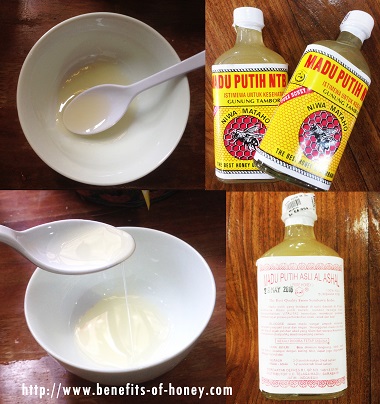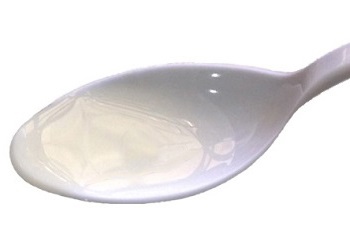
Is Indonesia's White Honey Real?
White honey? We are not referring to honey that has been processed into a light, creamed form. Dark color honey can change into a much lighter color after creaming. What we have here is a silky white liquid honey.
There are endless floral varietals of honey from all over the world, but have you ever thought any liquid honey could appear as white or milky in color? Because that has never occured to me, I was very skeptical when a salesgirl showed me two types of honey - the regular amber color honey and slightly yellowish (almost white) honey. (I had walked into a very quiet store selling local Indonesia products in Bali, Indonesia, looking for some honey.)
My mind stepped back, I spontaneously asked her why the honey was white and if it was pure real honey from the bees. She enthusiatically nodded her head many times and explained in her limited English that most locals prefered the white color honey to the regular honey (at least that was what I figured).

Could it have been adulterated with some starch or additives to make it look white? Or is this the expensive ultra-filtration process that the food industry uses to remove all fine particles by high pressure? But why would anyone do that? It doesn't make any sense, there is no incentive doing that. Even if it's fake, they must be trying to imitate a honey that is really white. Is it some royal jelly mixture or the like? The price would have been a few times more. Could it be an exotic honey like the intoxicating "mad honey" fom Nepal? It would be illegal for the stores here to sell such honey. I tried reasoning with myself and for every negative thought, I replaced with a positive one.
The labelling on the bottles had only a few English words, "Pure Honey" and "The Best Honey of Sumbawa" were meaningful to me, the rest of the text was in Indonesian language. Knowing that "Madu" on the bottle meant honey and "Putih", white was not enough to contribute to the buying decision process. The fact it looked so uniquely milky and watery compared to the regular golden liquid was too tempting for me to just dismiss it, walk away and forget about it. I grabbed two small bottles which appeared like 200ml in size (amount of honey was not indicated anywhere on the label) and each priced about 7 US dollars after conversion from Indonesia Rupiah. Fake or real, enough of guesses, we shall find out. You never try, you never know.
With no patience to wait till I go home and ask my Malay friends to translate the label, I eagerly typed out the whole chunk of Indonesia text into Google Translate, and the following was returned:
"White honey from one area on the island of Sumbawa gives new energy source, restores vitality, accelerates the growth process of children and babies. It is very effective against severe disease and mild disease. The advantage of honey is proven and commended in poems dozens of centuries ago. Most enduring drug of all time. Once tried, always prefered. It can be taken direct, better when mixed with egg yolk. It can also be used as a bread spread. Adults: 2-3 tablespoons, 3 times a day. Children: 1-2 teaspoons, 3 times a day."

Though somewhat vague, that resembled a medicine presciption. Nothing was mentioned about how good the taste was. But that was easy to find out, just eat it! The honey poured out from the bottle was very runny (typical of honey found in warm countries), translucent, released a pleasant, citrus burst of aroma, and tasted much like the honey from stingless bees found in in Asia. A very palatable honey. I liked it. The delicate yet distinctive fragrance of the floral nectar allayed much of my concern regarding authenticity.
Subsequent queries on the net led me to more information about this honey. Sumbawa is a remote, rugged island in West Nusa Tengarra, Indonesia, well-known for its wild honey produced by the Giant Honeybees (Apis Dorsata). On 13 July 2011, Antara, Indonesia's national news agency, reported that Sumbawa's white honey had become the icon of Indonesian honey because of its distinctive taste and quality. Other web sources published that white honey was sourced from bees that lived in white coral-reef. It is also used as a remedy for fever, colds, cough, ulcers, joint pains, and body fatigue. It is believed that it possessed exceptional benefits for the body, skin health and beauty, and could even treat neurological diseases.
I am still not completely sure if the honey is real or not. But it is certainly an exhilarating find for me!
Ruth Tan
August 2014
June 2018 (Updated)
Related Pages:
1. Are you eating real honey? How helpful are the labels and claims on honey bottles? More in: Eating Real Honey?
2. Do you eat honey from China? Read: Is Chinese Honey Fake Honey?
3. Wonder how stingless bees' honey taste like? Find out in: Stingless Bees are an Eye Opener.
4. Discovering honey in Hong Kong: In Search of Honey and Bees in Hong Kong.
End of "Is Indonesia's White Honey Real?". Back to "Exploring Honey Varieties!"